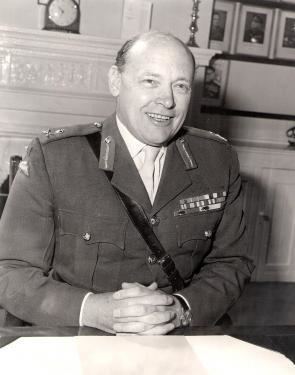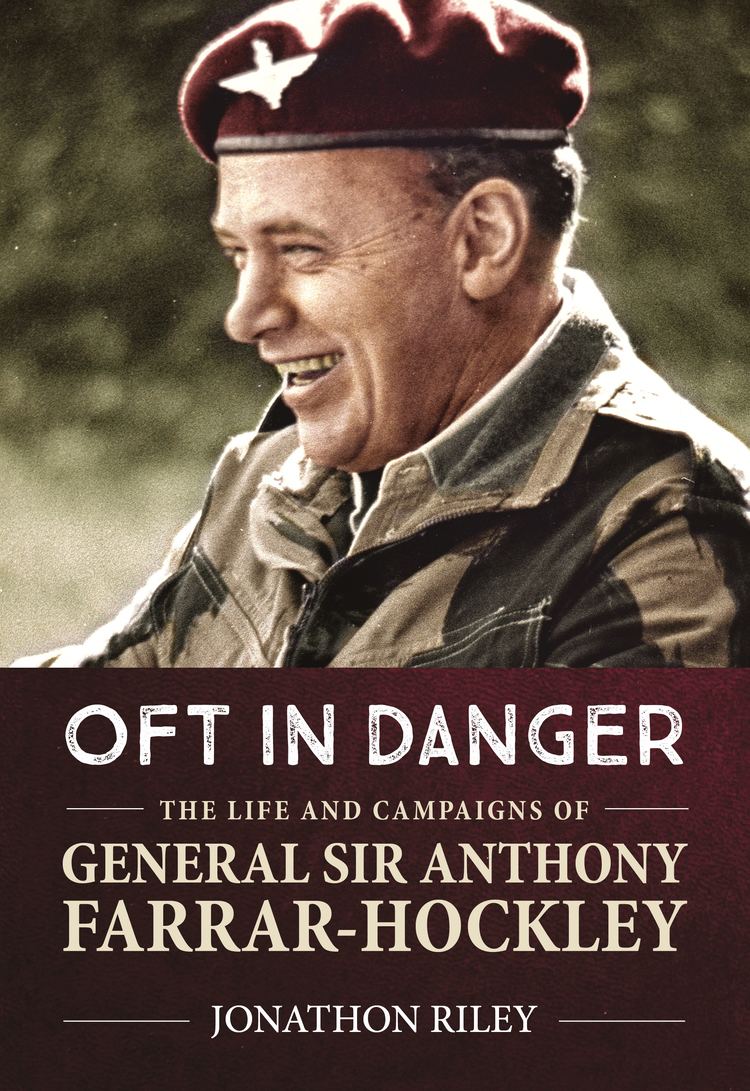Allegiance United Kingdom Years of service 1941–1982 | Children Dair Farrar-Hockley Name Anthony Farrar-Hockley | |
 | ||
Born 8 April 1924Coventry ( 1924-04-08 ) Commands held 3rd Battalion, Parachute Regiment16th Parachute Brigade4th DivisionSouth East DistrictAllied Forces Northern Europe Battles/wars World War IIGreek Civil WarKorean WarCyprus EmergencyIndonesian ConfrontationAden Emergency Awards Knight Grand Cross of the Order of the British EmpireKnight Commander of the Order of the BathDistinguished Service Order & BarMilitary CrossMentioned in Despatches (2) Died March 11, 2006, Oxford, United Kingdom Books The edge of the sword, Death of an Army, The Somme, Airborne Carpet: Operation, The British part in the Korean W | ||
General Sir Anthony Heritage Farrar-Hockley GBE, KCB, DSO & Bar, MC (8 April 1924 – 11 March 2006), affectionately known as 'Farrar the Para' , was a British Army officer and a military historian who distinguished himself in a number of British conflicts. He held a number of senior commands, ending his career as NATO's Commander-in-Chief Allied Forces Northern Europe.
Contents

Throughout his four decades of army life, he spoke plainly, and both before and after his retirement in 1982 wrote effectively on the conflicts he had experienced and the First World War.
Personal life
Anthony Farrar-Hockley was born in Coventry the son of a journalist. He was educated at Exeter School, at the age of 15 he ran away at the start of World War II and enlisted in the Gloucestershire Regiment, the fact that he was underage was soon discovered and he was discharged and had to wait to be re-enlisted in 1941. He was promoted sergeant while still aged 17 and only 18 when he was commissioned into the 1st Airborne Division in November 1942 and fought in Italy and France. Later he won the MC in 1944 while fighting the communist rebellion in Athens.
On 7 July 1945 in St Peter's Church, Ealing, he married Margaret B Wells with whom he had three sons (two of whom survive). His first wife died in 1981 and he married Linda Wood in 1983. Following in father's footsteps his elder son Charles Dair Farrar-Hockley also won an MC fighting with the Parachute Regiment in the Falklands War.
During his mid-career Farrar-Hockley was carrying out research and publishing. He established a reputation as an authority on World War I, publishing The Somme (1964) and Death of an Army (1968). By way of sabbatical during his military career he spent time (1968–1970) at Exeter College, Oxford as a Defence Fellow, working on a research project into the social effects of National Service in Britain and publishing two other books. He gained a BLitt at Oxford University.
Military career
At the outbreak of World War II in 1939, at the age of 15, Tony Farrar-Hockley ran away from school and enlisted in the ranks with the Gloucestershire Regiment. After the discovery of his age he was discharged. In 1941 he enlisted again and was posted to a Young Soldiers' Battalion. In 1942 he was commissioned and posted to the new 1st Airborne Division seeing action with the Parachute Regiment in Italy, France and Greece. He was still only 20 in 1944 when he was given command of a company in the 6th Battalion Parachute Regiment and later won an MC in Greece whilst resisting the communist rebellion in Athens.
After post-war service with the Glosters in Palestine, Farrar-Hockley fought in the Korean War, still with the Glosters as adjutant. He provided inspiring leadership during the Battle of the Imjin River and fight for Hill 235. "A" Company had undergone lengthy attack, taken severe officer casualties and was struggling. Farrar-Hockley volunteered to reinforce the company and his presence had an immediate effect. The company were able to retrench and hold on for some time. Nevertheless, they became surrounded, ran out of ammunition, and after hand-to-hand fighting with bayonets were ordered to withdraw. Farrar-Hockley organised an orderly withdrawal but as one of the last to leave the position he was captured. The Glosters became known as the Glorious Glosters and he was awarded the DSO although he was a captain and the DSO was usually reserved for more senior ranks. His citation stated:
Throughout this desperate engagement on which the ability of the Battalion to hold its position entirely depended, Captain Farrar-Hockley was an inspiration to the defenders. His outstanding gallantry, fighting spirit and great powers of leadership heartened his men and welded them into an indomitable team. His conduct could not have been surpassed.
Farrar-Hockley spent two years as a prisoner of war. He was mentioned in despatches for his conduct. After active service in the Cyprus Emergency (1956), Egypt (1956) and Jordan (1958), he spent some time at Royal Military Academy Sandhurst as chief instructor (1959–1961)
In 1962 he took command of 3rd Battalion, Parachute Regiment in the Persian Gulf. While there possibly the greatest feat of arms of his career took place in 1964 during the Aden Emergency when his battalion captured a stronghold held by nationalist and tribesmen in the Radfan mountains of north of Aden at Wadi Dhubsan. For this action Farrar-Hockley was awarded a Bar to his DSO.
1n 1965 Farrar-Hockley was posted as Chief of Staff to the Director of Operations in Borneo in the Far East. Indonesia under President Sukarno was confronting the new Federation of Malaysia. Secret and unattributable cross-border operations which Farrar-Hockley helped to organise on Indonesian territory helped bring the ill-judged military confrontation to an end.
After commanding (1966–1968) the 16th Parachute Brigade and his fellowship at Exeter College, Oxford (1968–1970) he was promoted to major general and appointed as the first Commander Land Forces in Belfast where he was the first senior officer to acknowledge publicly that the IRA was behind the violence. After this he commanded the 4th Division in BAOR (1971–1973) before returning to the Ministry of Defence where he was put in charge of Combat Development for the Army.
After a period as General Officer Commanding South East District (1977–1979) he was appointed commander in chief of Nato's Allied Forces Northern Europe. He held this appointment until his retirement from the army in 1982.
Later life
Other positions held by Farrar-Hockley included: ADC General to the Queen (1981–1983), Colonel-Commandant of the Prince of Wales' Division (1974–1980) and of the Parachute Regiment (1977–1983). He was colonel of his Gloucestershire Regiment 1978–1984.
During his retirement Farrar-Hockley carried out historical research and published campaign histories and biographies, he acted as a consultant and was a frequent pundit in the newspapers and on television and radio.
Farrar-Hockley was a target for the IRA having been found on an IRA hitlist in the 1980s. In 1990, his 5-year-old grandson found a bomb attached to a hose in his garden. The bomb failed to explode.
He declared to The Guardian that a secret arms network was established in Britain after the war, but refused to say if it still existed. He aroused controversy in 1983 when he became involved trying to organise a campaign for a new home guard against possible Soviet invasion and in 1990, following Italian Prime minister Giulio Andreotti's October 1990 revelations concerning Gladio, a NATO stay-behind network, he revealed that the armed anti-communist secret resistance network across western European had involved Britain.
His honours included: Mentioned in despatches 1943, MC 1944, DSO 1953, Mentioned in despatches 1954, MBE 1957, DSO bar 1964, KCB 1977, GBE 1982.
Works
From British Library catalogue (October 2006).
